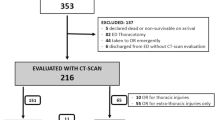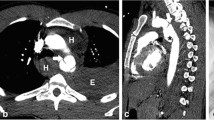Abstract
Purpose of Review
Penetrating chest trauma is a major cause of morbidity and mortality in the USA, with changes in imaging techniques due to the advent of chest computed tomography. In this paper, we aim to review current literature and discuss indications for chest computed tomography (CCT) in the setting of hemodynamically stable patients with penetrating chest trauma. This review will also discuss the different injury patterns seen in thoracic and transmediastinal injuries and how CCT can aid in the identification of clinically relevant penetrating injuries.
Recent Findings
Chest computed tomography has proven to be more sensitive compared to traditional plain x-ray and other invasive modalities for many of the injury patterns associated with penetrating chest trauma. Where it fails, however, is in the diagnosis of esophageal injuries, where esophagoscopy and esophagography remain superior to current imaging techniques. More recently, CT esophagography has gained traction in diagnosing esophageal injuries associated with penetrating trauma. Although limited to a small prospective cohort, the use of CT esophagography appears promising and will likely play a larger role in the future.
Summary
This review focuses on the current imaging trends for thoracic and transmediastinal injury patterns in penetrating chest trauma and discusses the indications and limitations of using chest computed tomography in these selected patients.





Similar content being viewed by others
References
Papers of particular interest, published recently, have been highlighted as: • Of importance •• Of major importance
Centers for Disease Control and Prevention, National Center for Health Statistics. Compressed Mortality, 1999-2015 Request. Available at: https://wonder.cdc.gov/cmf-icd10.html. Accessed 14 June 2017.
Durso A, Caban K, Munera F. Penetrating thoracic injury. Radiol Clin N Am. 2015;53(4):675–93. https://doi.org/10.1016/j.rcl.2015.02.010.
US Centers for Disease Control and Prevention WIS-QAR database. Available at: https://webappa.cdc.gov/sasweb/ncipc/leadcause.html. Accessed 14 June 2017.
Richardson JD, Flint LM, Snow NJ, Gray LA Jr, Trinkle JK. Management of transmediastinal gunshot wounds. Surgery. 1981;90(4):671–6.
Plurad D, Green D, Demetriades D, Rhee P. The increasing use of chest computed tomography for trauma: is it being overutilized? J Trauma Injury Infection Crit Care. 2006;62(3):631–5.
Mollberg NM, Wise SR, De Hoyos AL, Lin FJ, Merlotti G, Massad M. Chest computed tomography for penetrating thoracic trauma after normal screening chest roentgenogram. Ann Thorac Surg. 2012;93(6):1830–5. https://doi.org/10.1016/j.athoracsur.2012.02.095.
Lomoschitz FM, Eisenhuber E, Linnau KF, Peloschek P, Schoder M, Bankier AA. Imaging of chest trauma: radiological patterns of injury and diagnostic algorithms. Eur J Radiol. 2003;48(1):61–70. https://doi.org/10.1016/S0720-048X(03)00202-X.
Ball CG. Current management of penetrating torso trauma: nontherapeutic is not good enough anymore. Can J Surg. 2014;57(2):E36–43. https://doi.org/10.1503/cjs.026012.
Ibirogba S, Nicol AJ, Navsaria PH. Screening helical computed tomographic scanning in hemodynamic stable patients with transmediastinal gunshot wounds. Injury. 2007;38(1):48–52. https://doi.org/10.1016/j.injury.2006.07.039.
Hanpeter DE, Demetriades D, Asensio J, et al. Helical computed tomographic scan in the evaluation of mediastinal gunshot wounds. J Trauma. 2000;49:689–95.
Strumwasser A, Chong V, Chu E, Victorino GP. Thoracic computed tomography is an effective screening modality in patients with penetrating injuries to the chest. Injury Int J Care Injured. 2016;47(9):2000–5. https://doi.org/10.1016/j.injury.2016.05.040.
Seamon MJ, Medina CR, Pieri PG, Fisher CA, Gaughan JP, Bradley KM, et al. Follow-up after asymptomatic penetrating thoracic injury: 3 hours is enough. J Trauma Injury Infect Crit Care. Sept 2008;65(3):549–53. https://doi.org/10.1097/TA.0b013e31817fa463.
Shatz DV, de la Pedraja J, Erbella J, Hameed M, Vail SJ. Efficacy of follow-up evaluation in penetrating thoracic injuries: 3- vs. 6-hour radiographs of the chest. J Emerg Med. 2001;20(3):281–4. https://doi.org/10.1016/S0736-4679(01)00290-6.
•• Berg RJ, Inaba K, Recinos G, Barmparas G, Teixeira PG, Georgiou C, et al. Prospective evaluation of early follow-up chest radiography after penetrating thoracic injury. World J Surg. 2013;37(6):1286–90. It argues that early follow-up chest X-ray, at intervals approaching 1 h, is sufficient to exclude clinically significant injuries in patients with asymptomatic penetrating chest trauma
Magnotti LJ, Weinberg JA, Schroeppel TJ, Savage SA, Fischer PE, Bee TK, et al. Initial chest CT obviates the need for repeat chest radiograph after penetrating thoracic trauma. Am Surg. 2007;73(6):569–72.
McCollough CH, Bushberg JT, Fletcher JG, Eckel LJ. Answers to common questions about the use and safety of CT scans. Mayo Clin Proc. 2015;90(10):1380–92. https://doi.org/10.1016/j.mayocp.2015.07.011.
•• Gunn ML, Clark T, Sadro CT, Linnau KF, Sandstrom CK. Current concepts in imaging evaluation of penetrating transmediastinal injury. Radiographics. 2014;34(7) Serves as a good review of the use of CCT in penetrating transmediastinal injuries
Burack JH, Emad K, Sawas A, et al. Triage and outcome of patients with mediastinal penetrating trauma. Ann Thorac Surg. 2007;83:377–82.
Rivas LA, Fishman JE, Munera F, Bajayo DE. Multislice CT in thoracic trauma. Radiol Clin N Am. 2003;41(3):599–616. https://doi.org/10.1016/S0033-8389(03)00027-7.
Rhea JT, Sheridan RL, Mullins ME, Novelline RA. Can chest and abdominal trauma CT eliminate the need for plain films of the spine?—experience with 329 multiple trauma patients. Emerg Radiol. 2001;8(2):99–104. https://doi.org/10.1007/PL00011886.
• Rashi J, et al. Reassessing the cardiac box: a comprehensive evaluation of the relationship between thoracic gunshot wounds and cardiac injury. J Trauma Acute Care Surg. 2017;83(3):349–55. Authors argue that the cardiac box needs to be re-defined
Plurad DS, Bricker S, Van Natta TL, et al. Penetrating cardiac injury and the significance of chest computed tomography findings. Emerg Radiol. 2013;20:279–84.
Tack D, Defrance P, Delcour C, Gevenois PA. The CT fallen-lung sign. Eur Radiol. 2000;10(5):719–21. https://doi.org/10.1007/s003300050992.
Rossbach MM, Johnson SB, Gomez MA, Sako EY, Miller OL, Calhoon JH. Management of major tracheobronchial injuries: a 28-year experience. Ann Thorac Surg. 1998;65(1):182–6. https://doi.org/10.1016/S0003-4975(97)01001-1.
•• Conradie WJ, Gebremariam FA. Can computed tomography esophagography reliably diagnose traumatic penetrating upper digestive tract injuries? Clinical Imaging. 2015;39(6):1039–45. Discusses the use of CT esophagography in diagnosing upper digestive tract injuries due to penetrating trauma. In the future, this may replace traditional esophagography and esophagoscopy for diagnosis. More studies are required, however, to fully elucidate its effectiveness
Fusoon L, Huang YC, Ng Y, Liang JH. Differentiate pleural effusion from hemothorax after blunt chest trauma; comparison of computed tomography attenuation values. J Acute Med. 2016;6(1):1–6. https://doi.org/10.1016/j.jacme.2015.12.001.
Scharff JR, Naunheim KS. Traumatic diaphragmatic injuries. Thorac Surg Clin. 2007;17(1):81–5. https://doi.org/10.1016/j.thorsurg.2007.03.006.
Bosanquet D, Farboud A, Luckraz H. A review diaphragmatic injury. Respir Med CME. 2009;2(1):1–6. https://doi.org/10.1016/j.rmedc.2009.01.002.
Author information
Authors and Affiliations
Corresponding author
Ethics declarations
Conflict of Interest
The authors declare no conflicts of interest relevant to this manuscript.
Financial Disclosure
The authors have no financial interest to declare in relation to the content of this article.
Human and Animal Rights and Informed Consent
This article does not contain any studies with human or animal subjects performed by any of the authors.
Additional information
This article is part of the Topical Collection on Thoracic Trauma
Rights and permissions
About this article
Cite this article
Acevedo, E., Sjoholm, L.O., Santora, T. et al. A Review of the Role and Utility of Chest Computed Tomography in Penetrating Chest Trauma. Curr Trauma Rep 4, 56–63 (2018). https://doi.org/10.1007/s40719-018-0115-5
Published:
Issue Date:
DOI: https://doi.org/10.1007/s40719-018-0115-5




